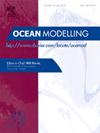不同机器学习算法的比较评估,用于估计北印度洋接近现实的盐度
IF 2.9
3区 地球科学
Q2 METEOROLOGY & ATMOSPHERIC SCIENCES
引用次数: 0
摘要
盐度影响水的密度,因此在质量、热量和盐在全球范围内的传输中起着重要作用。虽然北印度洋(NIO)的温度观测丰富,但盐度观测通常较少。准确估计声速分布对海军作战至关重要,特别是对水声通信和水下目标探测。通常,在海军任务中,操作人员依赖于消耗性深海温度仪(xbt)的原位点测量,并辅以气候盐度数据来推导声速剖面。在这项研究中,我们探索了三种机器学习技术的有效性:光梯度增强(LightGBM)、极端梯度增强(XGBoost)和人工神经网络(ANN),用于从温度数据中获取盐度剖面。这三种模型都表现良好,但XGBoost在测试数据集上的相关系数为0.975,且均方根误差值非常低,优于其他模型。为了进一步了解模型的行为,进行了敏感性分析,以确定对盐度剖面估计影响最大的参数。然后在沿海和开阔海域对模型的性能进行了评估。虽然总体上表现良好,但在训练数据有限的地区,特别是在海岸线附近,准确率略有下降。此外,我们利用位于NIO的独立海洋浮标的时间序列观测结果对模型进行了评估,结果清楚地表明该模型能够填补浮标盐度测量的空白。总之,这种监督学习模型为利用NIO区域的原位温度数据推导盐度剖面提供了一种强大的替代方案。在盐度数据有限的NIO区域实施该方法,对提高数据可用性和进一步开展海洋学研究具有重要意义。本文章由计算机程序翻译,如有差异,请以英文原文为准。

A comparative assessment of different machine learning algorithms for estimating near realistic salinity in the North Indian Ocean
Salinity affects the density of water and hence plays a significant role in the transport of mass, heat, and salt across the globe. Though temperature observations are abundant over the North Indian Ocean (NIO), the salinity observations are generally sparse. Accurate estimation of sound speed profiles is vital for naval operations, particularly for acoustic communication and underwater target detection. Typically, in naval missions, operators rely on in-situ point measurements from Expendable Bathythermographs (XBTs), supplemented by climatological salinity data for sound speed profile derivation. In this study, we explore the effectiveness of three machine learning techniques: Light Gradient Boosting (LightGBM), Extreme Gradient Boosting (XGBoost), and Artificial Neural Network (ANN) for deriving salinity profiles from temperature data. All three models performed well, but XGBoost outperformed the others with a strong correlation coefficient of 0.975 and a very low root mean square error value on the testing dataset. To gain further insights into the model’s behavior, a sensitivity analysis was conducted to identify the most influential parameters for salinity profile estimation. The model’s performance was then evaluated in the coastal and open ocean areas. While generally performing well, a slight decrease in accuracy was observed in areas with limited training data, particularly near coastlines. Furthermore, we evaluated the model using the time series observations from independent ocean buoys located in the NIO, and the results clearly recommended the model’s ability to fill the gaps in buoy-based salinity measurements. In conclusion, this supervised learning model presents a robust alternative for deriving salinity profiles using in-situ temperature data within the NIO region. Its implementation in the NIO region with limited salinity data holds significant promise for enhancing data availability and furthering oceanographic research.
求助全文
通过发布文献求助,成功后即可免费获取论文全文。
去求助
来源期刊

Ocean Modelling
地学-海洋学
CiteScore
5.50
自引率
9.40%
发文量
86
审稿时长
19.6 weeks
期刊介绍:
The main objective of Ocean Modelling is to provide rapid communication between those interested in ocean modelling, whether through direct observation, or through analytical, numerical or laboratory models, and including interactions between physical and biogeochemical or biological phenomena. Because of the intimate links between ocean and atmosphere, involvement of scientists interested in influences of either medium on the other is welcome. The journal has a wide scope and includes ocean-atmosphere interaction in various forms as well as pure ocean results. In addition to primary peer-reviewed papers, the journal provides review papers, preliminary communications, and discussions.
 求助内容:
求助内容: 应助结果提醒方式:
应助结果提醒方式:


